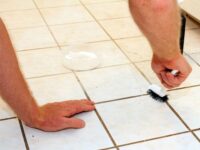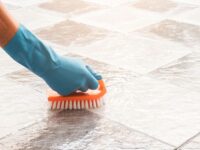Grout plays a vital role in keeping our floor tiles intact and ensuring their longevity. However, over time, grout can accumulate dirt, stains, and grime, making our floors look dull and unclean. In this article, we will explore the essential steps and techniques for how to clean grout on floor tiles, restoring their original beauty and ensuring a hygienic environment in your home.
Importance of Maintaining Clean Grout
Clean grout is not only aesthetically pleasing but also crucial for maintaining the durability and cleanliness of our tiled floors. Regularly cleaning grout helps prevent the growth of harmful bacteria, mold, and mildew, creating a healthier living space for you and your family. Moreover, by keeping the grout clean, we can extend the lifespan of our tiles, saving us the hassle and expense of premature replacements.
Tools and Materials Required for Cleaning Grout
Before embarking on the grout cleaning journey, gather the necessary tools and materials. You will need a grout cleaning brush or toothbrush, a bucket of warm water, a spray bottle, a grout cleaner (either homemade or commercial), a scrub pad or sponge, old towels or rags, and protective gloves and goggles. These items will help make the grout cleaning process more efficient and effective.
Preparing the Area for Grout Cleaning
To ensure smooth and effective grout cleaning, it’s important to prepare the area beforehand. Remove any furniture or objects that may hinder the cleaning process. Sweep or vacuum the floor to eliminate loose dirt and debris. This step ensures that you have a clean surface to work with and prevents dirt from being trapped in the grout during cleaning.

Understanding the Different Types of Grout
Grout comes in various types, such as cement-based, epoxy, and urethane grout. It’s important to understand the type of grout used in your tiles as different types require specific cleaning techniques and products. Identifying the type of grout helps you choose the appropriate cleaning method that won’t damage or discolor the grout.
Assessing the Condition of the Grout
Before diving into the cleaning process, take a close look at the condition of the grout. Determine if it is stained, discolored, or heavily soiled. Assessing the condition of the grout helps you gauge the intensity of cleaning required and whether additional steps, such as stain removal techniques, are necessary.
Choosing the Appropriate Cleaning Method for Your Grout
Based on the type and condition of your grout, it’s crucial to select the most suitable cleaning method. For light dirt and stains, homemade grout cleaners can be effective. These often involve ingredients like baking soda and vinegar. On the other hand, commercial grout cleaning products specifically formulated for different grout types offer convenience and efficiency.
Using Homemade Grout Cleaners
Homemade grout cleaners provide a cost-effective and environmentally friendly option for cleaning grout. Simple mixtures of baking soda and water or vinegar can create a paste that acts as a gentle abrasive to remove grime and stains. Apply the mixture to the grout lines, scrub with a brush, and rinse thoroughly.
Effective Commercial Grout Cleaning Products
Commercial grout cleaners are designed to tackle stubborn stains and deep-seated dirt. These products are available in spray or liquid form, with specialized formulas for different grout types. Follow the instructions on the packaging carefully, apply the cleaner, allow it to penetrate the grout, and then scrub or wipe away the residue.

Steps for Cleaning Grout Manually
For those who prefer a hands-on approach, cleaning grout manually is a viable option. Dip a grout cleaning brush or toothbrush into a bucket of warm water or a diluted grout cleaner solution. Scrub the grout lines using back-and-forth or circular motions, paying extra attention to heavily soiled areas. Rinse the brush frequently and change the water or solution as needed.
Using a Grout Cleaning Brush or Toothbrush
A grout cleaning brush or toothbrush is an effective tool for targeting grout lines. The bristles help agitate and remove dirt and grime from the grout surface. Use the brush with your chosen grout cleaner or homemade paste, applying pressure as needed to ensure thorough cleaning.
Applying Grout Cleaner and Scrubbing Techniques
When using grout cleaners, follow the instructions provided. Apply the cleaner directly to the grout lines and allow it to sit for the recommended duration. This allows the cleaner to penetrate and loosen the dirt and stains. Afterward, use your chosen scrubbing technique, such as a brush or toothbrush, to scrub the grout lines and remove the loosened grime. Rinse the area thoroughly with water to remove any residue.
Removing Tough Stains from Grout
Sometimes grout stains can be particularly stubborn. In such cases, additional steps and techniques may be required. For example, a mixture of hydrogen peroxide and baking soda can be effective for removing tough stains. Apply the paste to the stained areas, let it sit for some time, scrub gently, and rinse well.
Cleaning Colored Grout Without Causing Discoloration
If you have colored grout, it’s essential to take precautions to avoid discoloration during the cleaning process. Test any cleaner or method in a small, inconspicuous area before applying it to the entire grout surface. This helps ensure that the cleaning solution won’t cause any adverse effects or alter the color of the grout.

Techniques for Cleaning Large Areas of Grout
Cleaning large areas of grout can be time-consuming, but there are techniques to make the process more efficient. One approach is to divide the area into smaller sections and clean them one at a time. This allows you to focus on each section and ensures thorough cleaning without becoming overwhelmed.
Cleaning Grout in Hard-to-Reach Areas
Grout in hard-to-reach areas, such as corners and edges, may require special attention. In such cases, use a narrow brush or a toothbrush to access these tight spots. Alternatively, you can use a grout pen or marker specifically designed to refresh the color of grout in hard-to-reach areas.
Tips for Preventing Future Grout Stains
Prevention is key when it comes to grout maintenance. By taking a few proactive measures, you can minimize future grout stains. Consider applying a grout sealer to protect the grout from dirt and stains. Additionally, regularly sweeping or vacuuming your floors and promptly wiping up spills can help prevent the grout from becoming heavily soiled.
Sealing Grout for Long-Lasting Cleanliness
Sealing the grout is an effective way to protect it from stains and moisture. Once the grout is clean and fully dry, apply a grout sealer according to the manufacturer’s instructions. The sealer creates a protective barrier, making future cleaning easier and preventing dirt and stains from penetrating the grout.
Maintenance and Regular Cleaning of Grout
Regular maintenance and cleaning are essential for preserving clean grout. Develop a cleaning routine that suits your needs, considering factors such as foot traffic and the specific conditions of your environment. Regularly sweeping or vacuuming the floors, wiping up spills promptly, and periodically cleaning the grout will help maintain its cleanliness and extend its lifespan.
Troubleshooting Common Grout Cleaning Issues
Sometimes, despite our best efforts, issues may arise during the grout cleaning process. Common problems include residue left behind by cleaners, grout that remains discolored or stained, or damaged grout. In such cases, refer to specific troubleshooting techniques and consult with professionals if necessary.
Conclusion (How To Clean Grout On Floor Tiles?)
Cleaning grout on floor tiles is an important task to maintain the beauty, hygiene, and durability of your floors. By following the steps outlined in this article, using the appropriate tools and materials, and employing effective cleaning techniques, you can restore your grout to its original luster and enjoy clean and beautiful floors for years to come.





